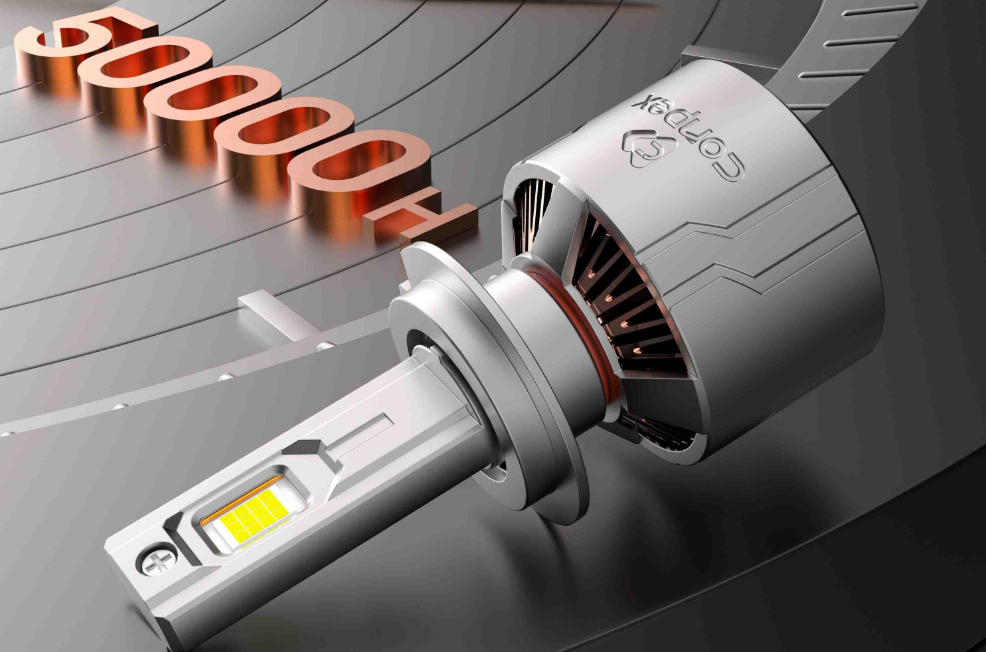What Affects the Lifespan of Automotive LED Headlights?
14 July 2025
by CONPEX
Reading volume: 1846
Automotive LED headlights are increasingly popular in the automotive industry due to their superior brightness, energy efficiency, and modern appearance. Whether you're upgrading your vehicle with car LED headlights or installing new car LED headlight bulbs, it's important to understand the factors that influence the lifespan of these lights.
LED headlights are known for their long life compared to traditional halogen bulbs, but they still face challenges that can shorten their effectiveness. We will discuss the main factors that affect the service life of car LED headlights to help you better understand car LED headlights.

1. Quality of the LED Chips
The quality of the LED chips used in your car LED headlight bulbs directly impacts their performance and lifespan. Higher-quality LEDs are designed to withstand heat and other environmental stresses better than cheaper alternatives.
Low-quality chips can cause the LED to overheat, which reduces its brightness and lifespan.
Premium-quality LEDs, such as those made from Cree or Samsung chips, are known for their durability and long-lasting performance.
When shopping for automotive LED headlights, always consider the brand and quality of the chips to ensure you're getting the longest-lasting option.
2. Heat Dissipation
Heat is one of the biggest enemies of LED lights. LEDs generate heat, and without proper heat dissipation, their lifespan can significantly decrease. Poorly designed heat management systems can cause the LED chips to degrade more quickly, reducing the brightness and efficiency of the automotive LED headlights.
High-end LED headlights feature advanced heat sinks, cooling fans, or fin, systems that help keep the lights cool.
Cheap or poorly designed LED bulbs may not have adequate heat management, which leads to overheating and early failure.
For car LED headlights, ensuring that the heat dissipation design is well-optimized is essential for maintaining their brightness and longevity.
3. Voltage Regulation and Electrical System Compatibility
The voltage supplied to your car LED headlight bulbs can also affect their lifespan. Overvoltage or fluctuating power can cause the LEDs to burn out prematurely. This is why car LED headlight bulbs must be compatible with your vehicle’s electrical system.
Car LED headlights equipped with built-in voltage regulation or CANBUS decoders ensure that the lights receive stable voltage, which helps prevent overheating and extends their lifespan.
Voltage surges caused by faulty wiring or incompatible systems can damage the LEDs over time, resulting in reduced life.
When purchasing automotive LED headlights, make sure they are compatible with your vehicle’s electrical setup, especially if your car is equipped with advanced electronic systems.
4. Environmental Factors and Driving Conditions
The environment in which you drive plays a significant role in the longevity of your LED headlights. Extreme weather conditions like heavy rain, snow, high humidity, or dusty roads can negatively impact the lifespan of the headlights.
Waterproofing: High-quality automotive LED headlights are designed to withstand water exposure without corroding or short-circuiting. If your car LED headlights are exposed to water, be sure that the lights have an IP65 or IP68 rating, indicating that they are waterproof.
Vibrations and Impact: If you drive on rough or off-road terrain, the vibration and impacts can wear down the housing and internal components of the car LED headlight bulbs, leading to early failure.
For better durability, opt for LED headlights with robust, shock-resistant housings that can handle challenging environments.
5. Installation Quality
Proper installation is another key factor in the lifespan of automotive LED headlights. Poor installation can lead to misalignment, improper voltage, or even exposure to moisture.
When installing car LED headlights, ensure that the bulbs are correctly fitted into the headlight housing to prevent water or dirt from entering and damaging the components.
Incorrect installation can also affect beam pattern, leading to poor illumination and putting unnecessary strain on the LED chips.
For optimal lifespan, always have your car LED headlight bulbs installed by a professional, especially if you’re upgrading to more complex systems or custom setups.
6. Quality of the Housing and Sealing
The housing of your automotive LED headlights plays an essential role in protecting the internal components from external elements like dust, water, and impact.
Durable, well-sealed housings prevent moisture and dust from reaching the LED chips, which can otherwise cause corrosion, dirt buildup, or fogging.Poorly sealed or fragile housings can lead to water ingress or physical damage, causing the LEDs to fail prematurely.
For car LED headlights or any car LED headlight bulbs, ensure that the hou
For car LED headlights or any car LED headlight bulbs, ensure that the housing is made from high-quality materials like aluminum or die-cast aluminum for better heat dissipation and durability.
Conclusion: Extending the Lifespan of Your Automotive LED Headlights
The lifespan of automotive LED headlights is influenced by several factors, including the quality of the LED chips, heat dissipation, electrical compatibility, environmental conditions, and installation quality. By choosing high-quality car LED headlight bulbs, ensuring proper installation, and considering environmental factors, you can maximize the longevity of your headlights.
Whether you’re upgrading to car LED headlights for better visibility or opting for high-performance LED bulbs, these features are critical to maintaining the reliability and effectiveness of your automotive lighting system for years to come.






